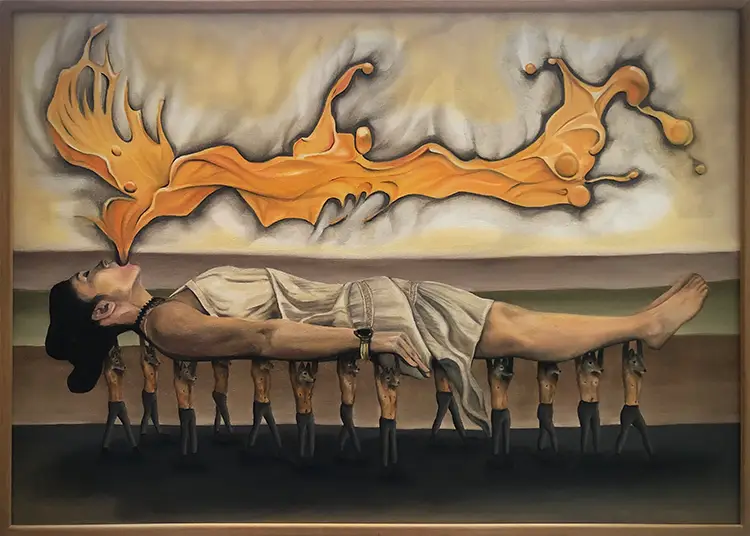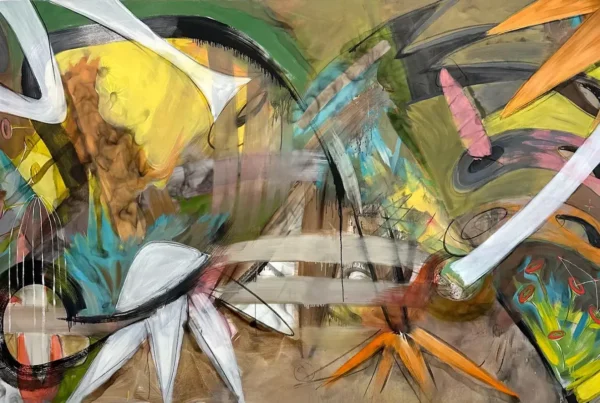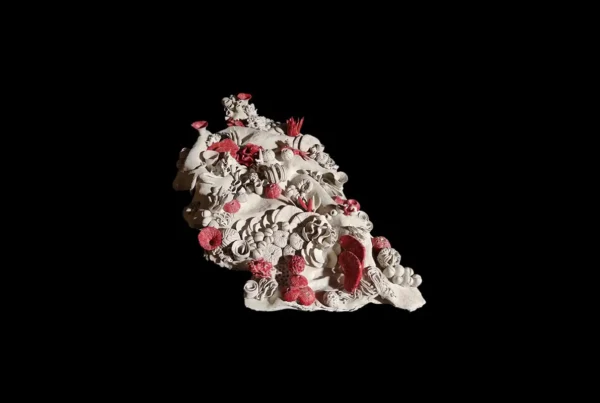“Part of us stays behind but never truly detaches, remaining in a dual state.”
Crosscurrents of Upbringing and Withdrawal
Rute Ventura’s creative life is shaped by a profound duality, a tension that echoes across her work with quiet intensity. Born in Lisbon in 1982 into a politically charged, post-dictatorship Portugal, Ventura came of age in an environment defined by contradiction: a strict patriarchal household intersecting with socialist ideals and working-class resilience. Her early life was shared with multiple generations under one roof, each carrying its own complex set of expectations and values. These layered influences forged the foundation for a practice that is introspective yet outward-looking, personal yet philosophical. At age 26, she relocated to New York City, a decision that introduced her to a thriving DIY artistic community while simultaneously amplifying her critique of the U.S. political structure. This dissonance between lived ideals and external systems continues to infuse her art with urgency and relevance.
The experience of immigration did not dilute Ventura’s critical voice; instead, it sharpened it. New York, with its chaotic energy and unrelenting speed, became both refuge and mirror. It provided space for her evolving creative identity while also reinforcing the ideological disillusionment she carries. Her work remains anchored in the collision between these two worlds—her Portuguese roots and her American reality—interrogating how history, politics, and socioeconomics shape the psyche. Ventura’s art practice is not simply informed by her background; it is carved from it. Her narrative, both as an artist and as a woman shaped by complex systems, becomes the canvas on which identity, power, and transformation unfold.
Ventura’s creative instinct is not an isolated aesthetic pursuit but a necessary channel of expression. The emotional labor of bridging contrasting environments—culturally, politically, and emotionally—makes itself visible through her chosen mediums. Her works are rarely spontaneous in concept, even when the technique arises organically. Whether it’s sculpture, poetry, or painting, Ventura’s pieces are charged with the psychological residue of her environments. They become a record of survival and self-discovery, where the act of making art is both testimony and resistance, an articulation of inner realities in dialogue with outer structures.
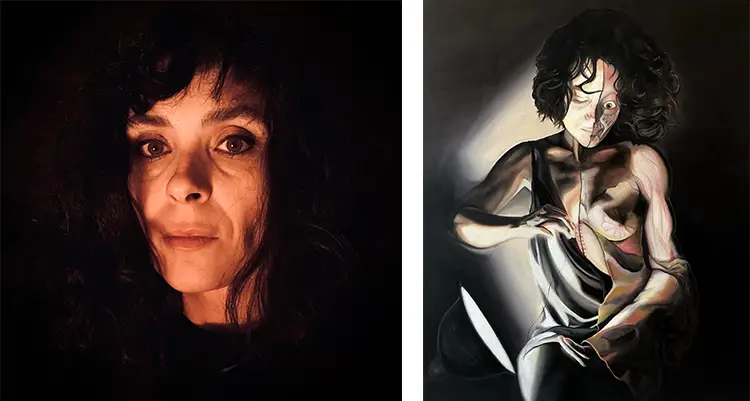
Rute Ventura: Art Born of Intuition and Unfinished Inheritance
While many artists trace their beginnings to formal education or early exposure to galleries and institutions, Ventura’s initiation into the arts emerged from a much more tactile world. Her early years were saturated with the textures and rhythms of labor. She observed both her grandmother’s sewing skills and domestic routine, as well as the aluminum manufacturing and craftsmanship of her grandfather. These memories were not simply familial; they became formative visual and emotional references. Her fascination with observation turned into skill, as educators and family alike recognized her natural ability in drawing. Encouraged by this validation, she entered an arts-focused high school, later pursuing academic studies in Drawing, Sculpture, and Fine Arts. However, despite this formal trajectory, painting did not enter her life until much later, marking it as a practice that arose from internal necessity rather than external instruction.
Her style resists neat categorization. Rather than adhering to a specific movement or technique, Ventura’s work flows instinctively from her inner world. The themes she revisits—identity, philosophy, metaphysics, allegory, dark symbology—aren’t chosen so much as they emerge. They are modes through which she makes sense of herself and the surrounding universe. These motifs resurface across different mediums, binding her body of work through a continuous exploration of what it means to be conscious, to be fractured, and to heal. Her aesthetic is shaped by a desire to reveal the unseen, not through abstraction, but through narrative images that challenge the viewer to look deeper.
What defines Ventura’s practice is its sincerity. Her work isn’t shaped to fit into art markets or trends but instead grows organically from her thoughts, emotions, and shifting states of awareness. She gives herself the space to pivot—from oils to poetry to performance—not out of restlessness but from an understanding that different experiences demand different languages. Rather than conforming to expectations, she follows an internal rhythm, allowing each piece to unfold in its own time. In this way, her art becomes an evolving diary of sensation and insight, never rushed, never performative, and always tethered to her pursuit of truth through metaphor and form.
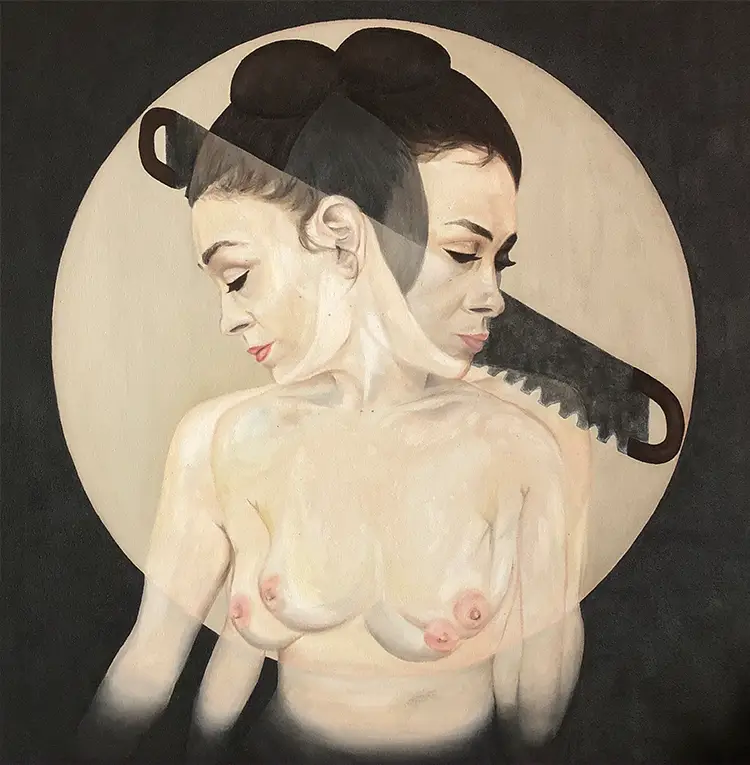
Symbol, Conflict, and the Weight of Choice
Ventura’s practice reaches its most poignant expression in works that blend personal symbolism with universal human emotion. Among these, Inner Conflict stands as a pivotal moment in her artistic journey. Created in December 2019, this oil painting self-portrait captures the sensation of being psychologically split—two versions of the same self torn by a decision that reshapes identity. In the image, a medieval saw penetrates her torso, not in violence but as a metaphorical instrument, bisecting her into mirrored bodies. The act of division becomes a visual metaphor for internal transformation, the kind brought about by confronting a life-altering decision. The piece speaks not only to the grief of what is left behind but also to the haunting persistence of that former self, one that never fully disappears.
The decision to portray such a moment through a historically charged visual object like a medieval saw adds gravity to the piece. It ties her inner conflict to a broader human history of suffering, division, and rebirth. The visual strategy blurs fantasy and realism, fusing the symbolic with the corporeal. Ventura does not seek to shock but to reveal; the pain in the image is real, but so is the necessity of enduring it. Inner Conflict marks a turning point in her practice, a moment where her visual language took on new dimensions, becoming more layered, more emotionally raw, and more precise in its allegorical power.
This painting did more than capture a personal struggle—it redefined how Ventura approached her own artistic identity. After Inner Conflict, her work leaned further into expressive and symbolic narratives, grounded not in aesthetic innovation for its own sake, but in the act of making meaning out of psychic fragmentation. Her art, from this moment on, became more deliberate in its attempt to communicate through emotional intensity and archetypal storytelling. The saw becomes more than a tool or a metaphor; it is a bridge between one version of the self and another, and the artwork itself becomes the space in which both can exist simultaneously, never quite merging, never entirely separate.
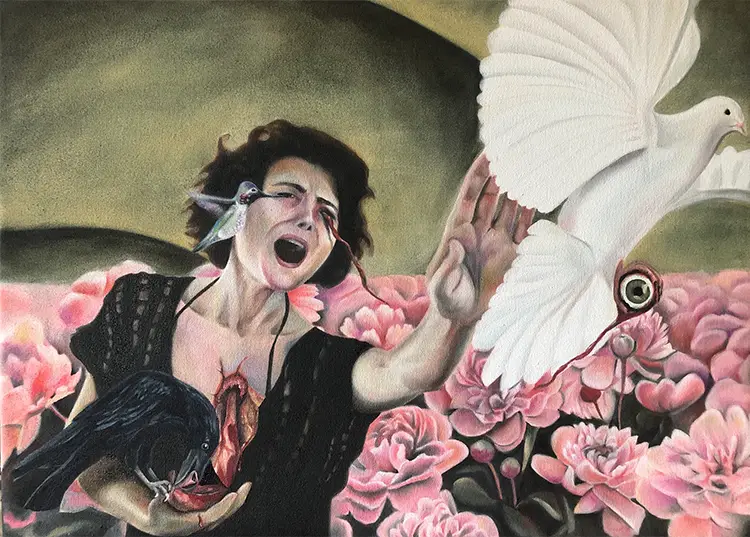
Rute Ventura: From Isolation to Embodied Presence
Art-making, for Ventura, is rarely a linear or predictable process. Her current lifestyle as a teaching artist working with under-resourced schools in New York City deeply shapes how and when she can create. Much of her own studio work takes place during evenings and weekends, fitting itself around the demands of her educational commitments. While this might seem limiting, it has actually introduced new modes of expression into her practice. Recently, Ventura has gravitated toward poetry and performance art, drawn to the immediacy and communal potential of these forms. Unlike painting, which often confines the artist to solitude, performance and poetry offer her a direct line to audiences, emphasizing presence, vulnerability, and shared experience.
This shift is not simply logistical but philosophical. Ventura has become increasingly aware of the importance of witnessing and being witnessed. She now views the act of sharing work—regardless of audience size—as a crucial part of its life cycle. An artwork unfinished until it is received, responded to, absorbed by another. This performative extension of her practice allows her to externalize what once lived solely in the private spaces of her studio and mind. Whether through voice, movement, or language, Ventura seeks to release her pieces into the world, allowing them to resonate beyond her individual narrative. The move toward public engagement becomes not a strategy for exposure, but a deepening of the work’s emotional and conceptual arc.
Still, the pull of painting remains strong. Even as she navigates poetry and video art, Ventura anticipates a return to her figurative oil works. She does not plan in advance what these next pieces will look like or what they will express; instead, she trusts the process will reveal itself when the moment is right. What she does know is that whatever form it takes, her work will continue to resist the superficial. It will speak through symbolism, gesture, and mood, inviting the viewer into a world that is not quite this one. Her next painting, like all her work, will be poetic, charged with meaning, and animated by a quiet urgency to connect, to express, and to transform.
